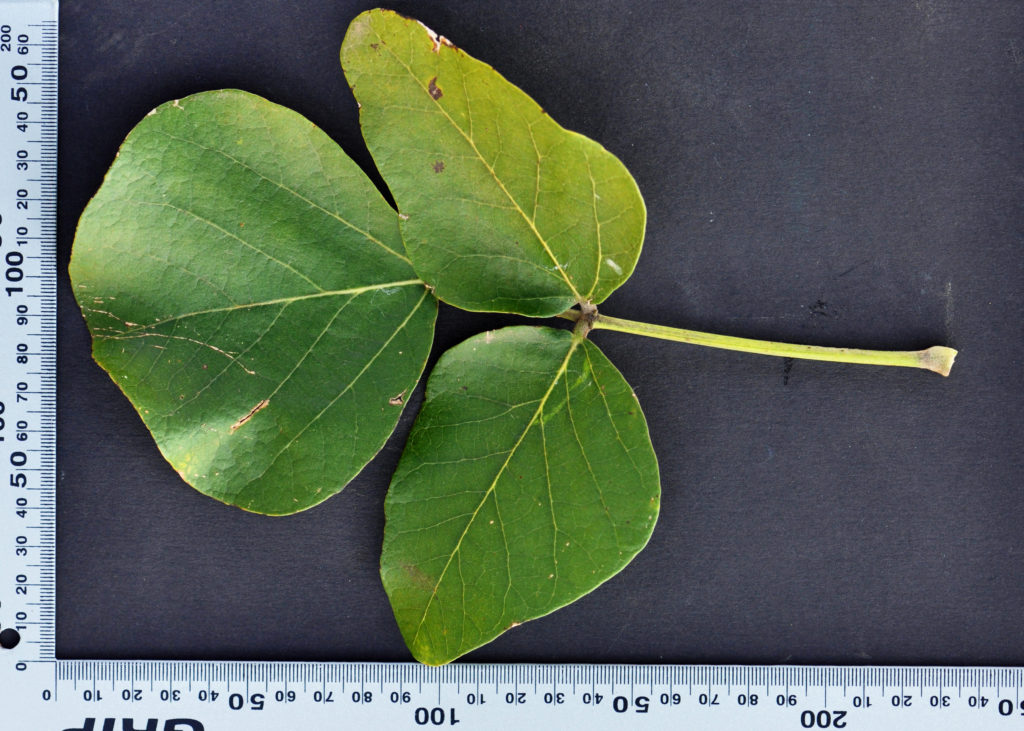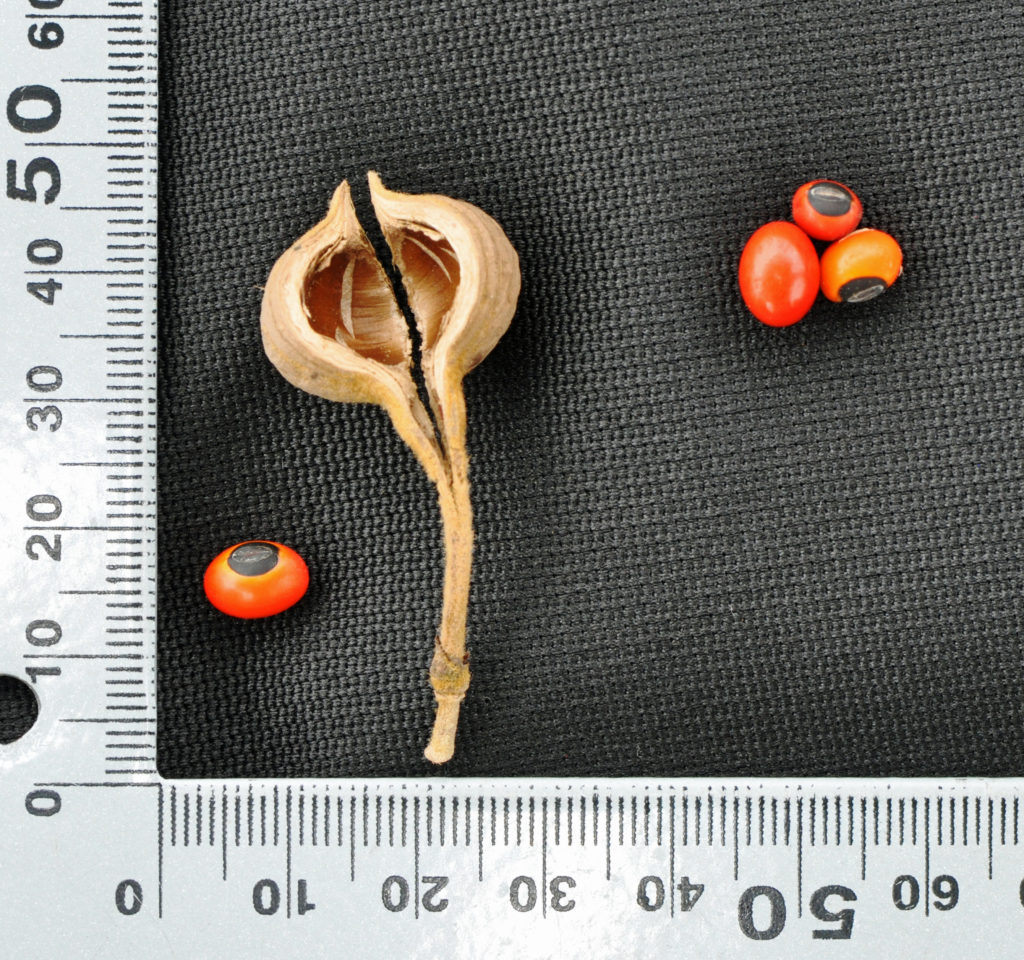General Info – summary
This thickset, deciduous Tree with its soft corky bark & rounded crown is up to 10m high and may have scattered spines. The trifoliate Leaves have leaflets that are 3-veined from the asymmetric base. Bisexual, zygomorphic, orange to scarlet Flowers are hairy & in racemes. 9 joined+1 stamens and a superior ovary with a long style are present. Fruit is a dehiscent, brown, woody & usually moniliform pod has red seed/s.
Description
Erythrina abyssinica
Previous Names: Erythrina latissimi, Erythrina tomentose.
SA Tree No. n/a.
Zimb Tree No. 363.
Common names: Red-hot-poker, Coral tree, Lucky-bean tree.
Family: Fabaceae, or Leguminosae (Pea, bean or legume family). After the Orchidaceae and the Asteraceae, the Fabaceae is the third largest Angiosperm (flowering plants) family with 700+ genera and close to 20 000 species. Local Tree genera on this website include Acacia (Vauchellia, Senegalia), Albizia, Bauhinia, Bolusanthus, Burkea, Calpurnia, Colophospermum, Cordyla, Cyclopia, Dichrostachys, Erythrina, Erythrophleum, Faidherbia, Indigofera, Mundulea, Peltophorum, Philenoptera, Piliostigma, Schotia and Xanthocercis. The Fabaceae are recognisable by their fruit and by their pinnately compound Leaves. Leaves may also be simple – even bilobed and usually have stipules – some of which may be spinescent. Leaflets are usually entire. Flowers are bisexual and bracteate. Regular flowers usually have 4-5 sepals and the same number of petals. Irregular flowers have 4-5 sepals and 5 or less petals. Stamens have anthers that have 2 pollen sacs and there are usually at least twice the number of stamens as petals – often 10. The superior Ovary has one locule that may contain 1 or more ovules. The Stigma and Style are simple. The single carpel develops into the Fruit, which is usually a pod. The fallen pods may break into segments. Seeds vary.
Name derivation: Erythrina from the Greek “erythros” meaning red – referring to the flowers. abyssinica – from Abyssinia (now Ethiopia). The “red flowered” genus Erythrina has about 120 species with 9 occurring in southern Africa.
Conservation Status: The IUCN Red List of Threatened Species. in 2018. Erythrina abyssinica was listed as Least Concern.
Tree
This thickset, medium-sized Tree (photo 765) is usually up to 10m high. It has a well-branched, rounded photo 60) or spreading crown. The Bark (photo 200) is thickly corky and light brown to grey. It is soft, very rough, and vertically fissured. Young, initially hairy Stems become hairless. Scattered spines are present.
- 765 2017.09.06 Walter Sisulu NBG. Photo: David Becking.
- 60 2014.04.29 Walter Sisulu NBG. Photo: David Becking.
- 207 2014.08.26 Walter Sisulu NBG. Photo: David Becking.
- 200 2014.06.03 Walter Sisulu NBG. Photo: David Becking.
Leaves
This deciduous tree (photos 60 and 207 under Tree) has hairy Leaves when young. Leaves are trifoliate (compound leaves with 3-leaflets). The Leaflets are almost as broad as long. They may appear slightly rhombic (4 sided which may be equal e.g., the terminal leaflet in photo 298). Leaflets are 3-veined from the base (photo 646). The Midrib, and hairy Rachis may have little prickles and Lateral veins are visible on both sides and protrude on the under-surface. Scattered prickles may be present on the midrib and Lateral veins. These veins run almost parallel towards the margins on each side. The Terminal leaflet (middle one in this case) is the largest (photo 298) – up to 14 x 14cm, and does not overlap the pair of smaller lateral leaflets. Young leaflets are hairy – especially below (photo 646). These hairs usually fall early. The Apex is rounded and may be notched (photo 646). The Base is broadly tapering and asymmetric (not equal to the opposite side). The leaflet Margins are entire (with continuous margins). Petioles (leaf stalks) are about 5-8cm long, have swollen bases (photo 295) and may have little prickles. The Petiolules (leaflet stalks) are up to 1cm long. Stipules (basal appendage of the petiole) are lanceolate with a tail-like appendage (photo 295).
- 298 2014.06.24 Walter Sisulu NBG. Photo: David Becking.
- 295 2014.06.24 Walter Sisulu NBG. Photo: David Becking.
- 646 2015.10.27 Walter Sisulu NBG. Photo: David Becking.
Flowers
Flowers and leaves in Erythrina latissimi are much bigger than those in Erythrina abyssinica. Here the early flowering, bisexual Flowers are up to 5cm long and are zygomorphic (irregular flower with the corolla only divisible into 2 equal halves in one plane only). The spectacular flowers occur in sturdy Racemes (simple elongated inflorescences with stalked flowers). The inflorescence may reach 20cm long and is held almost vertically (more horizontally in Erythrina latissimi). Flowers are axillary or in strong terminal pyramids at the ends of branches (photo 377) and usually appear before the leaves. These trees are most impressive when flowering – and may turn the entire crown red (photo 765) – if the winter has not been excessively cold. The Peduncle (stalk of flower cluster) may be up to 20cm long (photo 377). The Pedicel (stalk of a single flower in a cluster) is up to 6mm long (photo 433). The hairy Calyx is a cylindrical to spindle-shaped tube up to 2cm long and split on the lower surface. It is initially green (photo 586) but becomes red (photo 585). Its Lobes are up to 4,5cm long and are thin, protruding, tentacle-like structures. The Corolla is orange to scarlet. The Vexillum (Standard petal) is up to 3,5cm long and elliptical to ovate and folded thus appearing tubular. The 2 wing petals are up to 11 x 6mm and the 2 keel petals are free. There are 10 Stamens of the same length – 9 of which are joined near the base and the tenth is almost free. The Ovary is superior, and the long Style is thin and incurved. The Stigma is small. All visible parts of the bud and young flowers are hairy (photo 586). (Jul-Nov).
- 586 2015.09.22 Walter Sisulu NBG. Photo: David Becking.
- 377 2015.09.15 Walter Sisulu NBG. Photo: David Becking.
- 585 2015.09.22 Walter Sisulu NBG. Photo: David Becking.
- 433 2016.09.20 Walter Sisulu NBG. Photo: David Becking.
Fruit
The dehiscent, cylindrical, light brown, woody and usually hairy Fruit is a Pod from 4-15cm long. Prickles are present. Between 1 (photo 191) and 10 seeds are produced in each pod. When more than 1 seed is present, the sickle-shaped pod is moniliform (resembling a string of beads) – deeply constricted between the seeds. The ellipsoid Seeds are bright red with a conspicuous hilum (black spot indicating the point of previous attachment (photo 191) to the ovary wall. The mass of dry seeds is about 1kg for 1 000 seeds. (Nov-Mar).
- 191 2015.12.08 Walter Sisulu NBG. Photo: David Becking.
Distribution & Ecology
The natural Altitude range for this tree is from 800 to 2 000m. These plants grow on rocky hillsides, wooded grassland and bushveld (a sub-tropical woodland ecoregion of southern Africa). Countries where they occur naturally are Zimbabwe, central and northern Mozambique, Zambia, Uganda, Tanzania, DRC and northwards to Ethiopia. This tree is frost sensitive – especially when young. After a frosty winter, the flowering is less noticeable. Aided by the thickset trunk, mature trees are fire resistant and usually recover well after a fire. Flowers produce a lot of Nectar, and this attracts birds, which are largely responsible for pollination. The soft Wood is ideal for nesting birds. A number of butterfly larva feed on the Leaves. These include the Large Blue Emperor: (Charaxes bohemani). The hawk Moth (Falcatula falcatus) is also involved. These moths also feed on Sclerocarya caffra. The Roots fix atmospheric nitrogen in a symbiotic relationship with Rhizobia bacteria. This nitrogen fixation eventually has a positive effect on neighbouring plants.
Ethnobotany
The soft Wood is greyish white and may have shades of red. It is of a relatively low density and is used for making drums and floats for fishing nets. It usually has a straight grain and a coarse texture but is susceptible to fungal attack. The wood does not hold nails well. The Seeds are used to make necklaces. Note: the seeds are Poisonous – with an action similar to curare, which paralyzes motor nerves. However, this poison is not easily absorbed and handling of seeds is not usually a problem. It is a good-looking tree but frost sensitive – especially when young. Trees have a deep aggressive root system – plant away from walls. They can be Grown from seeds with about 30% germination rate. Seeds should be soaked in hot water and scarified (to slit or scratch the outer coat of seeds in order to speed up germination). They can also be grown from truncheons up to 3m long. These trees can be planted to create a live fence. Suggestion: plant together with the white flowering Dombeya rotundifolia – both are early flowering and are strikingly different. Leaves provide a reasonable Fodder source. Laboratory testing on extracts of roots and bark has revealed compounds with some Antimicrobial effects: supporting the use in traditional medicine.
References
Burrows, J.E., Burrows, S.M., Lotter, M.C. & Schmidt, E. 2018. Trees and Shrubs Mozambique. Publishing Print Matters (Pty) Ltd. Noordhoek, Cape Town.
Coates Palgrave, M. 2002. Keith Coates Palgrave Trees of Southern Africa, edn 3. Struik, Cape Town.
Palmer, E. & Pitman, N. 1972. Trees of southern Africa. Balkema, Amsterdam, Cape Town.
van Wyk, B. & van Wyk, P. 1997 Field guide to Trees of Southern Africa. Struik, Cape Town.
http://ntbg.org/plants/plant_details.php?plantid=11878
http://uses.plantnet-project.org/en/Erythrina_abyssinica_(PROTA)#Erythrina_sacleuxii
http://trees-4-zambia.com/product/erythrina-abyssinica-lam-ex-dc/
http://www.worldagroforestry.org/treedb/AFTPDFS/Erythrina_abyssinica.PDF
http://www.prota4u.org/protav8.asp?p=Erythrina+abyssinica
http://posa.sanbi.org/flora/browse.php?src=SP
https://www.prota4u.org/database/protav8.asp?g=pe&p=Erythrina+abyssinica+Lam.+ex+DC.
https://en.wikipedia.org/wiki/Falcatula_falcatus
Erythrina abyssinica (iucnredlist.org)

















